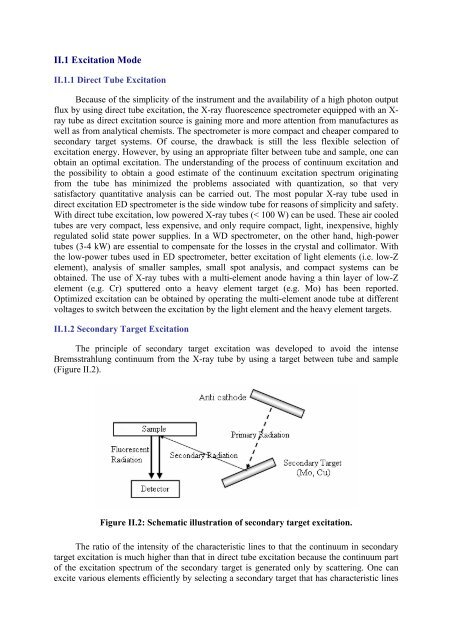X-Ray Fluorescence Analytical Techniques - CNSTN : Centre ...
X-Ray Fluorescence Analytical Techniques - CNSTN : Centre ...
X-Ray Fluorescence Analytical Techniques - CNSTN : Centre ...
You also want an ePaper? Increase the reach of your titles
YUMPU automatically turns print PDFs into web optimized ePapers that Google loves.
II.1 Excitation Mode<br />
II.1.1 Direct Tube Excitation<br />
Because of the simplicity of the instrument and the availability of a high photon output<br />
flux by using direct tube excitation, the X-ray fluorescence spectrometer equipped with an Xray<br />
tube as direct excitation source is gaining more and more attention from manufactures as<br />
well as from analytical chemists. The spectrometer is more compact and cheaper compared to<br />
secondary target systems. Of course, the drawback is still the less flexible selection of<br />
excitation energy. However, by using an appropriate filter between tube and sample, one can<br />
obtain an optimal excitation. The understanding of the process of continuum excitation and<br />
the possibility to obtain a good estimate of the continuum excitation spectrum originating<br />
from the tube has minimized the problems associated with quantization, so that very<br />
satisfactory quantitative analysis can be carried out. The most popular X-ray tube used in<br />
direct excitation ED spectrometer is the side window tube for reasons of simplicity and safety.<br />
With direct tube excitation, low powered X-ray tubes (< 100 W) can be used. These air cooled<br />
tubes are very compact, less expensive, and only require compact, light, inexpensive, highly<br />
regulated solid state power supplies. In a WD spectrometer, on the other hand, high-power<br />
tubes (3-4 kW) are essential to compensate for the losses in the crystal and collimator. With<br />
the low-power tubes used in ED spectrometer, better excitation of light elements (i.e. low-Z<br />
element), analysis of smaller samples, small spot analysis, and compact systems can be<br />
obtained. The use of X-ray tubes with a multi-element anode having a thin layer of low-Z<br />
element (e.g. Cr) sputtered onto a heavy element target (e.g. Mo) has been reported.<br />
Optimized excitation can be obtained by operating the multi-element anode tube at different<br />
voltages to switch between the excitation by the light element and the heavy element targets.<br />
II.1.2 Secondary Target Excitation<br />
The principle of secondary target excitation was developed to avoid the intense<br />
Bremsstrahlung continuum from the X-ray tube by using a target between tube and sample<br />
(Figure II.2).<br />
Figure II.2: Schematic illustration of secondary target excitation.<br />
The ratio of the intensity of the characteristic lines to that the continuum in secondary<br />
target excitation is much higher than that in direct tube excitation because the continuum part<br />
of the excitation spectrum of the secondary target is generated only by scattering. One can<br />
excite various elements efficiently by selecting a secondary target that has characteristic lines


